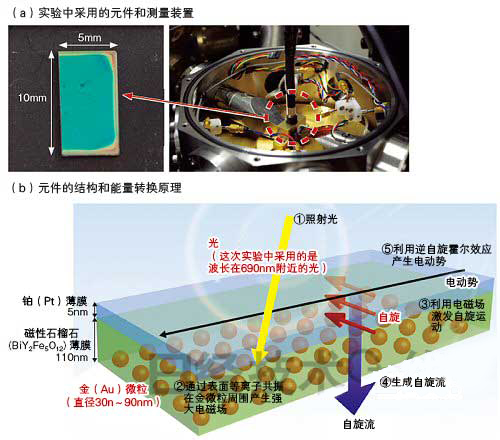The energy harvesting technology of Tohoku University in Japan uses a component to successfully convert heat, sound, and light into tiny electricity. According to Kenichi Uchida, an associate professor of materials at the Tohoku University in Japan, following the development of a technology that converts temperature differences and sound waves into tiny electric power, this time "developed a new technology that turns light into tiny electric power."
Birth of new research area
Uchida Kenichi's research lab has developed technologies to convert temperature differences and sound waves into "spin flows," and has also established a technology that converts temperature differences and sound waves into spin currents and then converts them into tiny electric powers.
In 2008, Tohoku University in Japan discovered the "Spin Seebeck effect" that generates spin current when the magnet has a temperature difference. In 2010, it was found that the insulator also produces a spin Seebeck effect. The new research area “spin caloritronics†was born. Northeastern University of Japan and NEC began to collaborate on new thermoelectric conversion elements. In 2011, both parties discovered that the use of sound waves can also generate spin currents.
This time, Tohoku University in Japan and Japan's Atomic Energy Research and Development Agency jointly developed a technique for irradiating insulators with light to generate spin currents. Note 1). The experiment also confirmed that using experimental components, the temperature difference can be converted into tiny electric power.
Note 1) Related research results were published on "Nature Communications" on January 8, 2015 (UK time).
Electromagnetic fields around Au particles
The element that generates the spin current from light this time is a magnetic 110 nm thick insulator (BiY2Fe5O12) thin film containing gold (Au) particles (diameter: 30 to 90 nm). A 5 nm thick platinum (Pt) film was applied to the surface. The device area is 10mm x 5mm (Figure 1).
When this element is irradiated with light having a wavelength in the vicinity of 690 nm in the visible light region, surface plasmon resonance occurs, and a local strong electromagnetic field is generated around the Au particle. The electromagnetic field will excite the spin motion in the magnetic garnet and stimulate the spin flow in the upper Pt film. Under the quantum relativistic effect of solid in the "counter-spin Hall effect" that generates electromotive force in the direction perpendicular to the spin flow, the spin current is converted into minute electric power.

Figure 1: Using light to generate spin current
Tohoku University in Japan developed a new energy conversion technology that emits light to an insulator to generate a spin current and derives it as an electric current. (Figures: (a) Photo and (b) Chart provided by Tohoku University)
Experiments have shown that the incident light with a wavelength around 690 nm produces an electromagnetic field around the Au particles, and the light transmittance decreases (Fig. 2). In addition, by detecting the electromotive force generated by the inverse spin Hall effect, it was found that the detected signal indeed originated from the spin current generated by the magnetic garnet.

Figure 2: Reactions with light near 690nm
The gold particles used this time were irradiated with light having a wavelength near 690 nm, and a strong electromagnetic field (a) was generated due to surface plasmon resonance. After irradiating light having a wavelength near 690 nm to an element containing such gold fine particles, the light transmittance was found to decrease, and the spin current intensity was increased (b). Components without gold particles have no change in the value measured near 690 nm. (Photo: Photograph of (a) is provided by Tohoku University, (b) Image is drawn by this site based on data from Tohoku University.)
The existing problem is low output power
However, the tiny electric power converted from light through a spin current "is much smaller than an equivalent solar cell" (Uchida). Because the efficiency of generating spin flow from light and the efficiency of converting from spin flow to electricity are both low. Therefore, instead of using it in the field of energy, it is better to first open up new applications that use the interaction between surface plasmons and spin currents.
If the research results of the thermoelectric conversion element using the spin Seebeck effect can be diverted, it is possible to improve the efficiency of spin flow generated by light and the efficiency of conversion from spin flow to current. (Reporter: He Jiji)
Super Duplex Seamless & Welded BW Fittings
Duplex stainless steels are becoming more common. They are being offered by all the major stainless steel mills for a number of reasons:
Higher strength leading to weight saving
Greater corrosion resistance particularly stress corrosion cracking
Better price stability
SAF 2507 ®is a registered trademark for Sandvik
This is a Duplex alloy stainless steel designed to feature high strength, resistance to pitting, stress corrosion cracking, erosion corrosion and corrosion fatigue, crevice corrosion and strong weldability.
Duplex Fittings,Duplex Pipe Fitting,Duplex Stainless Steel Pipe Fitting,Duplex Butt Welded Fitting
Zhejiang Max Stainless Steel Co.,Ltd , https://www.cnstainlesstube.com